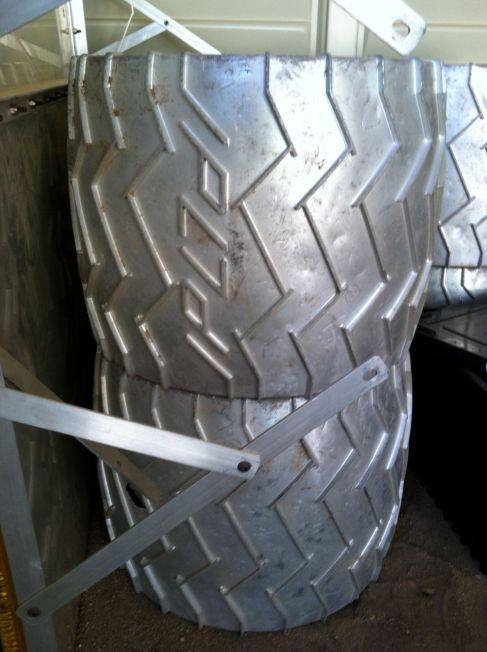OCO_2 Launch Pad Images
Images from this afternoon at Vandenberg AFB, Flight Complex 2 in preparation for the OCO-2 launch:
Images from this afternoon at Vandenberg AFB, Flight Complex 2 in preparation for the OCO-2 launch:
OCO-2 is Scheduled for launch in the early hours of 1 July, 2014 from flight complex 2 at Vandenberg AFB. The launch should be visible from many Southern California and Central Coast areas. For more about OCO-2:
http://eospso.gsfc.nasa.gov/sites/default/files/publications/OCO-2MissionBrochure_final_508.pdf
Some of you are probably asking why are they using Morse Code code on the Curiosity Rover tires instead of just printing the letters JPL on the tires for Visual Odometry?
The original Engineering design and indeed the original Rover tested in the desert had tires that read JPL as they covered the landscape. Apparently, someone at NASA HQ (we are told by a reliable source) said “no, no, and no” to JPL on the tires. However, Visual Odometry remains an important part of this mission; a decision had to be made about how to accomplish this task.

Original engineering model tires in the back of a garage in the Mars Yard at JPL. photo credit: Hellwinger
Although we can’t say for certain, it would seem that using letters rather than random holes makes sense and given that there are three horizontal treads are devoted to odometric encoding on the Rover’s tires that would give them three letters to work with.
The rest is history as they say; a decision to use Morse Code gives the science and engineering team its Visual Odometry while conveying a sence of wonder and whimsy. For me, I like to think that every time Curiosity looks back at where it’s been, she sees a reminder of her first home, Jet Propulsion Laboratory.
This panorama is a great series of shots of Curiosity’s beefy tires. You notice the strategic holes in the tires? They are actually Morse Code, spelling out J – P – L, the acronym for NASA’s Jet Propulsion Laboratory. This unique pattern is used by Curiosity to accurately gauge how far it’s been by creating a unique pattern to use for visual odometry.
By using a known pattern, the Rover can look back and assess any number of situations; when traveling in a relatively featureless area, it can see where it has been, judge traction in high slippage areas, such as sand dunes and compare how far it has actually come along with its actual location. All of this by seeing this unique pattern in the Martian regolith!
To learn more about Visual Odometry visit:
http://www.nasa.gov/mission_pages/msl/news/msl20120829f.html
We’re watching as people all around the world cheer on the Rover that could! The energy is palpable as we stop to wait for the OK, a signal that tells us Curiosity is on the surface and ON.
What we didn’t expect was to see images! Staring at the big screens, the question in the air was “what’s that?” followed by a cheer that broke like a wave as we realized it was an image Curiosity was sending back from Mars.
photo credit: JPL
Having spent a portion of the afternoon volunteering at Planetfest, the Planetary Society’s exhibition and lecture event, we hunkered down to watch MSL make it’s descent.
Here’s NASA’s quick look at “Fast Facts” on the Curiosity Rover:
Rover name: Curiosity rover
Size: About the size of a small SUV — 10 feet long (not including the arm), 9 feet wide and 7 feet tall — (about 3 meters long (not including the arm), 2.7 meters wide, and 2.2 meters tall), or about the height of a basketball player.
Arm Reach: About 7 feet (2.2 meters)
Weight: 900 kilograms (2,000 pounds)
Features: Geology lab, rocker-bogie suspension, rock-vaporizing laser and lots of cameras
Mission: To search areas of Mars for past or present conditions favorable for life, and conditions capable of preserving a record of life
Launched:
7:02 a.m. PST, Nov. 26, 2011
(10:02 a.m. EST)
Landed:
10:32 p.m. PDT, Aug. 5, 2012
(1:32 a.m. EDT, Aug. 6, 2012)
Length of mission on Mars: The prime mission will last one Mars year or about 23 Earth months.
Follow Your Curiosity:
Participate
Mission Fact sheet: Download theMars Science Laboratory Fact Sheet (PDF, 562 KB)
A great look at what needs to go exactly as planned in order for the MSL to survive its descent and landing to complete it’s mission.
http://video.nationalgeographic.com/video/news/space-technology-news/mars-curiosity-rover-vin/
From the Ames Research Center Facebook site:
“This full-resolution self-portrait shows the deck of NASA’s Curiosity rover from the rover’s Navigation camera. The back of the rover can be seen at the top left of the image, and two of the rover’s right side wheels can be seen on the left. The undulating rim of Gale Crater forms the lighter color strip in the background. Bits of gravel, about 0.4 inches (1 centimeter) in size, are visible on the deck of the rover.
Where News and Community Meet
stories from the sidewalk
The Official Home of DINOS™
Promoting Science and Science Education
Promoting Science and Science Education